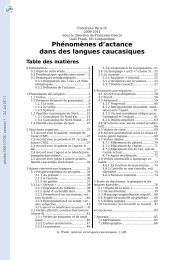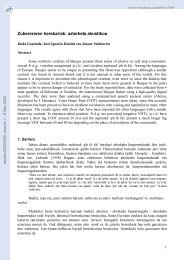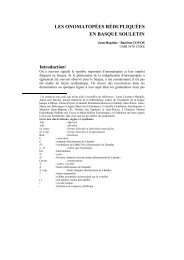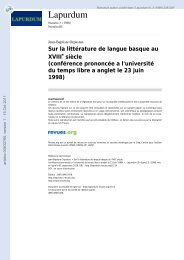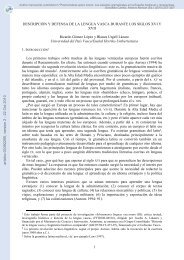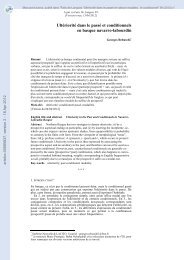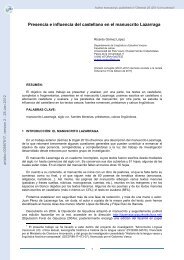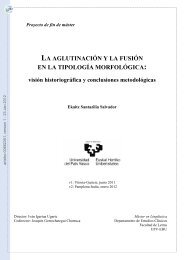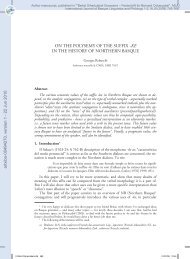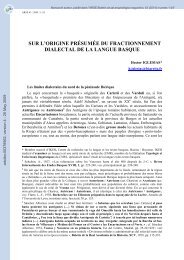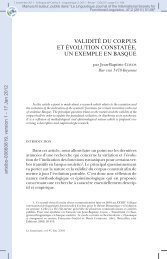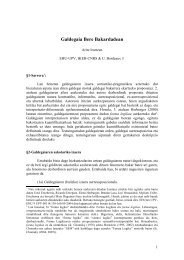La marge sud-marocaine et les premières phases d'ouverture de l ...
La marge sud-marocaine et les premières phases d'ouverture de l ...
La marge sud-marocaine et les premières phases d'ouverture de l ...
Create successful ePaper yourself
Turn your PDF publications into a flip-book with our unique Google optimized e-Paper software.
tel-00266944, version 1 - 26 Mar 2008<br />
Chapitre II : Etu<strong>de</strong> cinématique<br />
- un segment septentrional, le plus échantillonné, composé <strong>de</strong> <strong>de</strong>ux branches, entre<br />
26°N <strong>et</strong> 35°N, représentant <strong>les</strong> anomalies S,<br />
- un segment central, entre 20°N <strong>et</strong> 24°N, schématisé à partir <strong>de</strong>s données pétrolières<br />
(comm. pers.), <strong>et</strong> marqué par une seule anomalie,<br />
- un segment <strong>sud</strong>, situé entre 15°N <strong>et</strong> 20°N, qui correspond à l’anomalie continentale<br />
du Sénégal complétée par <strong>de</strong>s données en mer. Ces <strong>de</strong>ux anomalies constituent un doubl<strong>et</strong>, à<br />
l’image <strong>de</strong> leur homologue américain.<br />
Au Nord <strong>de</strong> 26°N, <strong>les</strong> travaux <strong>de</strong> Roeser (1982) ont permis <strong>de</strong> cartographier pour la<br />
première fois une anomalie (dénommée S1), très semblable à la ECMA par sa forme <strong>et</strong> sa<br />
situation (figure II-12). Toutefois, <strong>de</strong>ux différences majeures sont à noter : une amplitu<strong>de</strong><br />
n<strong>et</strong>tement moindre <strong>et</strong> une prolongation vers le Nord (<strong>de</strong> 32.25°N à 34.6°N). Sahabi (2004) <strong>et</strong><br />
Sahabi <strong>et</strong> al. (2004) appellent c<strong>et</strong>te <strong>de</strong>rnière anomalie « S’ », portion <strong>de</strong> l’anomalie S1<br />
dépourvue <strong>de</strong> symétrie. Une autre anomalie, S3, double en partie l’anomalie S1 entre 29°N <strong>et</strong><br />
32°N, lui donnant une allure comparable à la ECMA sur la <strong>marge</strong> canadienne. L’ensemble<br />
<strong>de</strong> ces anomalies S (Slope) constitue un doubl<strong>et</strong> <strong>et</strong> semble se terminer au Sud vers 26.30°N, à<br />
la rencontre du Sahara marocain.<br />
Plus au Sud, entre 20.5°N <strong>et</strong> 25°N, une anomalie côtière semblable à l’anomalie S a<br />
été découverte par Rona <strong>et</strong> al. (1970). Il s’agit d’une anomalie magnétique positive adjacente<br />
à la <strong>marge</strong>, d’amplitu<strong>de</strong> variant <strong>de</strong> 80 nT à 100 nT, qui ne montre pas <strong>de</strong> dédoublement. Son<br />
orientation est double : au nord <strong>de</strong> la latitu<strong>de</strong> 22.5°N, elle suit une direction NE-SO ; au <strong>sud</strong><br />
<strong>de</strong> 22.5°N, elle s’oriente N-S. Les données <strong>de</strong>s pétroliers (comm. pers.) nous ont permis <strong>de</strong><br />
définir avec précision le contourage <strong>de</strong> c<strong>et</strong>te anomalie.<br />
Plus au Sud encore, entre <strong>les</strong> latitu<strong>de</strong>s 15°N <strong>et</strong> 18°N, Liger (1980) a décrit <strong>et</strong><br />
interprété une anomalie rectiligne sur plus <strong>de</strong> 300 km, tout comme le segment <strong>de</strong> la ECMA<br />
qui lui fait face. Sur la base <strong>de</strong> ces travaux, Roussel and Liger (1983) <strong>et</strong> Oliv<strong>et</strong> <strong>et</strong> al. (1984)<br />
estiment que c<strong>et</strong>te anomalie du Sénégal constitue la terminaison <strong>sud</strong> <strong>de</strong> l’anomalie S <strong>et</strong> que<br />
l’ensemble forme l’homologue <strong>de</strong> la ECMA : la WACMA (West Coast African Magn<strong>et</strong>ic<br />
Anomaly). Les travaux récents <strong>de</strong> Sahabi (2004) <strong>et</strong> Sahabi <strong>et</strong> al. (2004) soulignent<br />
l’existence d’une anomalie magnétique, située en mer entre <strong>les</strong> latitu<strong>de</strong>s 15°N <strong>et</strong> 20°N,<br />
parallèle à l’anomalie continentale du Sénégal. Ces auteurs ont proposé que l’ensemble<br />
formé par l’anomalie du Sénégal <strong>et</strong> c<strong>et</strong>te anomalie soit le doubl<strong>et</strong> homologue qui marque<br />
ainsi le bord <strong>de</strong> la <strong>marge</strong> africaine.<br />
____________________<br />
24



